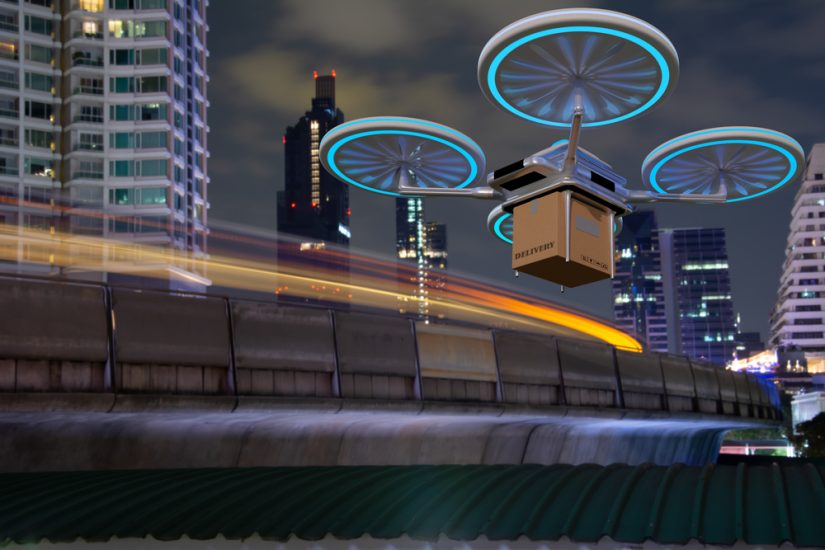By Philip Butterworth-Hayes
Last week’s Innovative Air Mobility Implementation Forum organised by the European Union Aviation Safety Agency (EASA) took stock of progress towards developing U-space airspace areas in Europe.
EASA is establishing an action plan that will be shared and followed up with EU drone association and authorities, according to Natale Di Rubbo, Drone Project Manager at EASA in a Linkedin post. In the same post he summarised three key messages from the forum: industry wanted simplified regulations, an expanded open category, new standard scenarios, and streamlined approvals process, particularly for low-risk operations. In terms of EASA’s call to Industry, the agency is encouraging drone companies to join EU drone associations, allowing a unified voice to support EASA in setting priorities and proposing solutions. And EASA also wants operators to share operational data (e.g., flight hours, occurrences) with authorities, helping evaluate the effectiveness and proportionality of regulations and apply ‘Just Culture’ principles reporting any occurrence with the aim to improve safety.
So, is Europe ready for airspace?
It was clear from the presentations and conversations at the event that the core technology is now available – and has been tried and tested in the ports of Hamburg, Antwerp and Rotterdam – to support the four mandatory U-space services: Network Identification Service (providing the identity of the operator, the location, and the trajectory of the drone); Geo-Awareness Service (providing information on airspace limitations, operational conditions, and existing time restrictions); Flight Clearance Service (ensuring that operations are free of conflict with other UAS operating in the same airspace) and Traffic Information Service.
The first U-space data and service providers are currently undergoing the EASA certification process and the first U-space area has been defined and will go live at the end of this month.
But meeting the core criteria for technology implementation in a single eco-system is not the same as building a viable business for U-space data and service providers across the European Union. It is this leap in moving from initial applications to delivery at scale that EASA was seeking to address at the event, with the added involvement of industry via the different European associations.
“EASA is reaching out to associations and sees a pivotal role for them,” said Koen De Vos, Secretary General of the Global UTM Association (GUTMA). “They contributed to the organization of the conference, spoke with a single voice, and will become even more intensely involved in the implementation of the regulatory framework in the course of 2025.”
So what was industry saying?
According to Jan-Erik Putze, President of the Board of Alliance for New Mobility Europe there are three main operational issues:
- Delays in operational authorisations by national aviation authorities;
- Standardisation of regulations across Member States;
- And access to U-space airspace.
Kevin Houston, President of Drone Alliance Europe, said a viable business model is at the very core of the challenge and without it there is no future. His association was concerned about:
- Standardisation of Specific Operations Risk Assessment (SORA) applications and their assessments across NAAs;
- Addressing overlaps between open and low risk specific category operations (proportionality);
- Supporting creation of commercially scalable and interoperable BVLOS operations;
- Standardisation of SORA applications and their assessments across NAAs
- Addressing overlaps between open and low risk specific category operations (proportionality)
- And supporting creation of commercially scalable and interoperable BVLOS operations
GUTMA and the Joint European Drone Associations (JEDA) added further concerns. GUTMA presented the preliminary results of its UTM readiness index, showing the steady progress in regulation but a slow progress in governance (such as insufficient cooperation between public and private entities) and strategy (a lack of low level airspace strategy). There were few U-space applications ongoing and technology development had not progressed much beyond basic tools of geo-awareness. There was, in general, a low level of understanding of the low level economy.
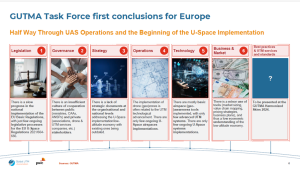
Julie Garland, President of JEDA, gave the association’s feedback from strategic issues (there is inconsistent implementation of drone regulations across EU countries and the cost and complexity of regulations are disproportionate to the actual risks) to more tactical concerns (buffer zones are hindering business operations and time-consuming and costly authorisation processes are discouraging investment).
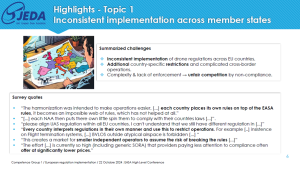
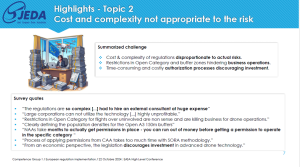
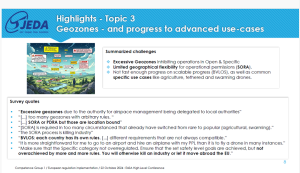
Which all means there is plenty still for EASA to do, although the challenge of simplifying and/or reducing regulations will not be easy. And it will push Member States further into the role of key blockers as they are ultimately the stakeholders tasked with implementing EU rules at a national level.
“We moved from discussing the general concept of a USSP certification process to listening to the concrete expertise gained by both the certified organization and the certificating authority. It still will take a while before the first commercial BVLOS operations can take placeat scale,” said GUTMA’s Koen De Vos. But the process could be accelerated by promoting collaboration between civil aviation authorities and industry associations taking a more proactive role. “If the EU does not move swiftly, the markets will be taken,” he concluded.
(Image: Shutterstock)



